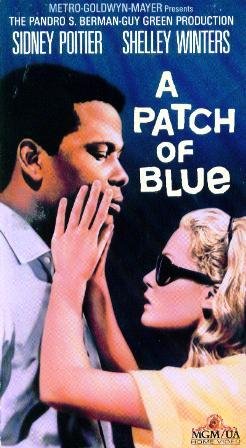
A PATCH OF BLUE
US, 1965, 105 minutes, Black and white.
Elizabeth Hartman, Sidney Poitier, Shelley Winters, Wallace Ford.
Directed by Guy Green.
A Patch of Blue is a film full of potential sentimentality which does not succumb to its temptations. Instead we have a moving message film that is strong in feeling, but strong as well. Elizabeth Kata's novel has provided the basis for a story of friendship which transcends human limitations - blindness, poverty, Ignorance, loneliness and racial
prejudice,
Sidney Poitier (in the years of The Slender Thread, Guess Who's Coming to Dinner, To Sir With Love and In the Heat of the Night) gives one of his ingratiating personalities as a black light that comes into the dark life of a blind girl who is white, played well by Elizabeth Hartman. Shelley Winters, as the girl's mother, gives one of her renditions of a slattern. She won an Oscar for it as Best Supporting Actress for 1965.
The film was written and directed by Guy Green who also directed The Angry Silence, Diamond Head, The Magus and A Walk in the Spring Rain. A moving film which can be widely recommended.
1. How was the title explained in the film? Was it an apt title? How did the musical score contribute to the film's mood and impact?
2. First feelings for Selina - her home, chores, being bullied, little loved, her beads - as well as being blind?
3. Why did she love the park so much? What did it mean to her? What was the significance of her 'seeing' dream in the park?
4. How helpless and dependant was she in her blindness - on old Pa, Mr Faber, on Gordon? How terrified was she in her helplessness - the caterpillar, the spilt beads, the dark (although she said 'I'm always in the dark'), the storm, the traffic, the people bumping, into her?
5. Why did Rose- Ann abuse her so much? Did she have any feelings for others? Did she love Selina at all? Did she feel guilty about Salina’s being blinded? What kind of a woman was Rose- Ann?
6. Did Old Pa love Selina? Why didn't he do anything much for her? How much was selfishness, how much was helplessness?
7. Why didn't Mr. Faber do more for Selina besides giving her the beads to work and helping her to the park?
8. Why did Gordon befriend her? What appealed to him? What was the significance of his pretending to be blind at his office? What was the significance of his giving her things? What was the significance of being delicate towards her and of teaching her things?
9. How happy did this make her? Why? How did she come to depend on him? Her sorrow when he was late? How did the film show the nature of true friendship? Which sequences illustrate this beet? "Everybody ought to have a friend. " "Tolerance. " The story about Pearl?
10. What did the flashbacks contribute to understanding Selina? - note how 'subjective' they were.
11. Comment on the sequence, and its impact, where she listens to the radio, goes out, is bewildered, is brought home and is unhappy. Then the message comes and transforms her into happiness.
12. What was the significance of the sequences at Gordon's home and Mark's comments, Selina's learning about Gordon, the music box her saying she wanted to make love to him?
13. How important was the race issue? How was the theme treated - from Selina's part, from Gordon's, from Rose-Ann's and her friends?
14. Was the climax effective - the scene in the park? How?
15. Was the resolution the best possible - Selina learning the realities of time, change, waiting?
16. What effect does a film like this have on its audience? Does it help them? Does it improve then? How? Why?